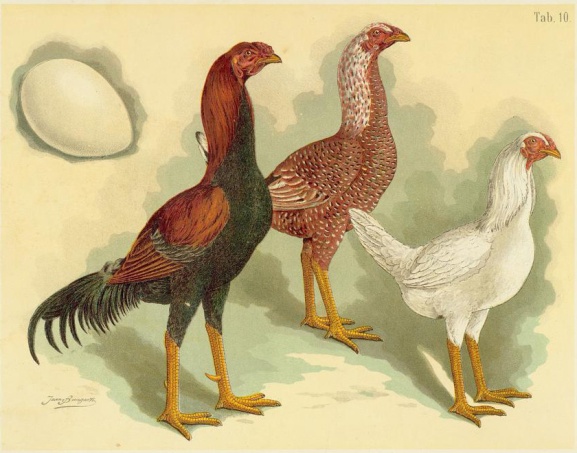Tags

Malays Fowls by Jean Bungartz for ‘Geflügel-Album’, 1885
In studying chickens one cannot merely search for the modern name of the chicken to know what early sorts were like as names sometimes came about after a group of fowl were improved upon enough to merit some distinction. I invite you to join me as I travel down the path in search of an intriguing bird known as the Shakebag fowl.
Numerous sources from 1800-1810 state that the fowl got its name from being held in a bag while the owner cried that he would take any comers who wished to pit their cocks against his in a cock-fight. The chicken was kept in a bag, out of sight, so the competitors could not judge the size and disposition of the bird they’d be pitted against. At the start of the match the bag would be turned upside down and the bird “shaken” out thus they came to be called Shakebag fowl. As one would imagine, Moubray classed the Shakebag as a game chicken and their breeder was described in 1853 as being an enthusiastic cock-fighter. – Dixon, Edmund Saul & Kerr, J. J. “A Treatise on the History and Management of Ornamental and Domestic Poultry”. Philadelphia. 1853.
They are often discussed when observing the Dorking which most agreed descended from crosses with the Shakebags. Dickson said, “It is very probable that this large breed is a cross between the Malay, or shack-back [shake-bag,] and the game variety.” Another writer put forth the same hypothesis in the “Scottish Quarterly Journal of Agriculture”, vol. VI, p. 381. Dickson’s wording seems to indicate that the Malay and the Shakebag were one and the same. – “The Cultivator”. Vol. 6. Feb. 1849.
Bennett tells us he has no doubt. The Shakebag fowl possessed too many points of affinity with the Malay for him to doubt the association. The plumage of the cock was described as extremely brilliant and gaudy. In 1850 he claimed the first presence of these fowls he had knowledge of in the U.S. were imported by Mr. John L. Tucker of Tremont House in Boston. He did not give a date for the importation. At the time of that writing Mr. James S. Parker of Samoset House, Plymouth supposedly had Shakebags among his fowl but pronounced them exceedingly rare in this country, this being the only importation Bennett was aware of.
English writers disputed Bennett’s claim regarding Misters Tucker and Parker saying instead that Moubray had declared the breed already extinct “for some years” in 1816 – some 34 years before Bennett’s statement of seeing them in the U.S in 1850. They thought the fowl that Tucker and Parker possessed were average dunghill fowl. – “The New England Farmer”. Vol. 2. June 8, 1850.
“The average weight [of the Shakebag] is from eight to fourteen pounds. The hens are good layers, and the eggs have every mark of the East Indian origin of the race, being dark-colored and large yolked. The cocks are remarkable for their prowess”. – Bennett, John C. “The Poultry Book”.
Richardson said, “A good many years ago, there used to be a variety of fowl much in request in England, called the ‘Shakebag’, or the ‘Duke of Leeds’ fowl’, his grace, of that name, about sixty or seventy years ago having been a great amateur breeder of them. These fowl were as large as the Malays, but differed from them in the superior whiteness and tenderness of their flesh, as also in their very superior fighting abilities”. Calculating back from 1847 he was saying the duke was breeding the Shackbags between 1772 and 1787. Note the use of the words “used to be” strengthening the claim they were already extinct by 1847. – Richardson, H. D. “Domestic Fowl: Their Natural History…”. Dublin. 1847.
The “New England Farmer”, June 8, 1850, noted that the Shakebag had been extinct for a good many years, but if speculation on its crosses is accurate, some of its traits live on in fowl by other names. Not all breeders agreed with the Malay being used in the cross. Some authors felt the Shakebags were crossed with the Java rather than Malay. – Tucker, I. “The Pictorial Cultivator”. Aug. 1850.
Moubray wrote in 1816, “The only one I ever possessed was a red one, in 1784, weighing about ten pounds, which was provided for me, at the price of one guinea, by Goff, the dealer, who then lived upon Holborn Hill, in London, and who, at the end of two years, received him back at half a guinea, having allowed me, in the interim, three shillings and sixpence each for such thoroughbred cock chickens as I chose to send him”. The Duke of Leeds, or Shakebag, fowl was already said to be rare prompting its cross with the Malays and other breeds. The Malay cross retained the size of the bird, but the flesh deteriorated in color and delicacy of flavor. – “Moubray’s Treatise on Domestic and Ornamental Poultry”. London. 1854.
To understand the crossing, it may be helpful to know the same source included under the name Malay fowl known as the Jersey Blue, the Bucks County, and “Boobies”.
Since the only illustration found of the Shakebag was questioned as to its accuracy when published in the mid-19th century, this writer proposes no physical description of the shape or coloring of the birds other than to imagine the color to have been similar to some sort of modern game bird and based upon period descriptions to note they were bigger than an average game chicken. Perhaps someone else has found a better description and will comment on it. Blissful Meals yall – Victoria Brady (The Historic Foodie). Please do not circulate articles from the Historic Foodie blog, in all or in part, without permission and without quoting the source. ©










You must be logged in to post a comment.